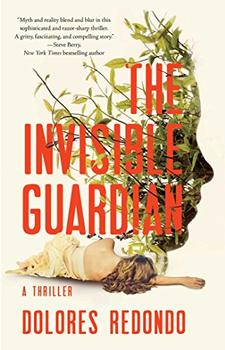Summary | Excerpt | Reviews | Beyond the Book | Read-Alikes | Genres & Themes | Author Bio

This article relates to The Invisible Guardian
 The eponymous guardian in Dolores Redondo's The Invisible Guardian refers to a mythical Basque creature called a basajaun. According to a character in the book, "[B]asajauns are real creatures, hominids about two and a half meters tall, with broad shoulders, long hair on their heads, and thick hair all over their bodies…They live in the woods and are an intrinsic part of them, acting as protectors. According to legends, they make sure the harmony of the forest remains intact." This fictional character may believe basajauns are real, however, like Yeti, the Loch Ness Monster and Bigfoot, a basajaun has rarely-to-never been seen and has yet to be caught on film.
The eponymous guardian in Dolores Redondo's The Invisible Guardian refers to a mythical Basque creature called a basajaun. According to a character in the book, "[B]asajauns are real creatures, hominids about two and a half meters tall, with broad shoulders, long hair on their heads, and thick hair all over their bodies…They live in the woods and are an intrinsic part of them, acting as protectors. According to legends, they make sure the harmony of the forest remains intact." This fictional character may believe basajauns are real, however, like Yeti, the Loch Ness Monster and Bigfoot, a basajaun has rarely-to-never been seen and has yet to be caught on film.
Still, regardless of their elusiveness – or maybe because of it – an entire field has arisen devoted to the study of, and hunt for, concrete proof that such creatures actually exist. According to the website New Animal, cryptozoology "is the study of animals and other creatures that have not yet been accepted by science as real. In other words, it is monster-hunting. Cryptozoologists look for creatures like sea serpents and the yeti, hoping to gather enough evidence to prove that these beings exist. They also look for more commonplace animals, such as the ivory-billed woodpecker, the giant vampire bat, the inflatable hedgehog and the pygmy elephant."
 A Frenchman, Bernard Heuvelmans, is commonly known as the Father of Cryptozoology. Born in 1916 Heuvelmans was captivated by the prospect that creatures yet to be catalogued by zoologists actually existed at the far corners of the planet. In 1955 he published a massive volume, On the Track of Unknown Animals, in which he chronicled as many of these so-called cryptids as were known at the time. Since there was no scientific field of study pursuant to the likes of the Abominable Snowman or Chupacabra, it is believed that he is the first to coin the term Cryptozoology, calling the creatures cryptids.
A Frenchman, Bernard Heuvelmans, is commonly known as the Father of Cryptozoology. Born in 1916 Heuvelmans was captivated by the prospect that creatures yet to be catalogued by zoologists actually existed at the far corners of the planet. In 1955 he published a massive volume, On the Track of Unknown Animals, in which he chronicled as many of these so-called cryptids as were known at the time. Since there was no scientific field of study pursuant to the likes of the Abominable Snowman or Chupacabra, it is believed that he is the first to coin the term Cryptozoology, calling the creatures cryptids.
Throughout his life Heuvelmans traveled to the furthest reaches of the planet – from jungle to mountaintop and more – in pursuit of eyewitness accounts and actual physical evidence of these fantastic beasts.
 On the event of his death in August 2001 an obituary notes, "Heuvelmans wrote in 1984: 'I tried to write about it according to the rules of scientific documentation.' Because of the unorthodox nature of his interests, however, he had no institutional sponsorship and had to support himself with his writing. 'That is why,' he wrote, 'I have always had to make my books fascinating for the largest possible audience.' Heuvelmans and his book influenced the investigative work of oil-magnate and cryptozoology patron Tom Slick. [Biologist and writer Ivan] Sanderson, who had influenced Heuvelmans, was in turn influenced by him. Heuvelmans served as a confidential consultant, along with Ivan Sanderson and anthropologist George Agogino, on Slick's secret board of advisors."
On the event of his death in August 2001 an obituary notes, "Heuvelmans wrote in 1984: 'I tried to write about it according to the rules of scientific documentation.' Because of the unorthodox nature of his interests, however, he had no institutional sponsorship and had to support himself with his writing. 'That is why,' he wrote, 'I have always had to make my books fascinating for the largest possible audience.' Heuvelmans and his book influenced the investigative work of oil-magnate and cryptozoology patron Tom Slick. [Biologist and writer Ivan] Sanderson, who had influenced Heuvelmans, was in turn influenced by him. Heuvelmans served as a confidential consultant, along with Ivan Sanderson and anthropologist George Agogino, on Slick's secret board of advisors."
Artist's depiction of a basajaun and its female companion, a basandere. (And what a depiction! Is this the artist's vision of a mythological beast or his fantasy of a mythological beast?)
Bernard Heuvelmans, illustrated by his wife, Alika Lindbergh
Graphic depiction of a Chupacabra, drawn by LeCire
Filed under Cultural Curiosities
![]() This "beyond the book article" relates to The Invisible Guardian. It originally ran in May 2016 and has been updated for the
September 2017 paperback edition.
Go to magazine.
This "beyond the book article" relates to The Invisible Guardian. It originally ran in May 2016 and has been updated for the
September 2017 paperback edition.
Go to magazine.
Your guide toexceptional books
BookBrowse seeks out and recommends the best in contemporary fiction and nonfiction—books that not only engage and entertain but also deepen our understanding of ourselves and the world around us.